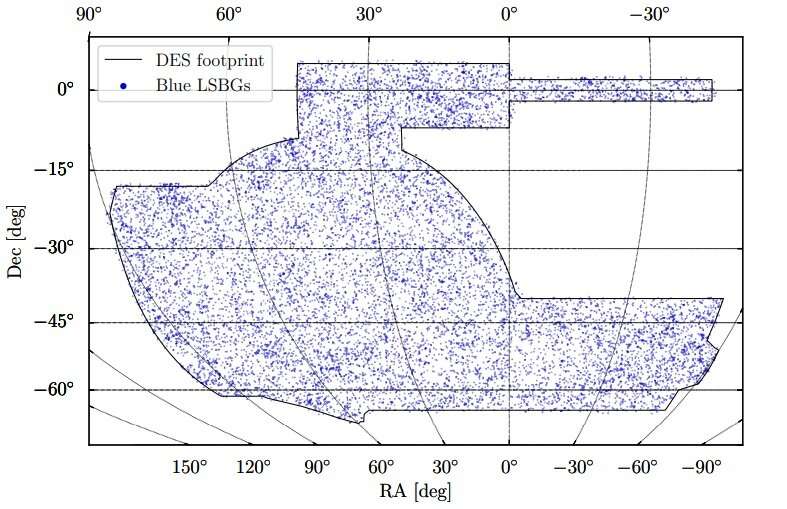Sky positions of blue LSBGs within the DES footprint. Credit: Tanoglidis et al., 2020.
An international team of astronomers has identified nearly 21,000 low-surface-brightness galaxies (LSBGs) in the Dark Energy Survey (DES). The detection of such a huge sample could be essential to improving our knowledge about how LSBGs form and evolve. The finding is reported in a paper published June 8 on arXiv.org.
In general, LSBGs are galaxies with central surface brightnesses fainter than the night sky. Due to this, they are difficult to detect and study, which has led to their underrepresentation in optical surveys conducted so far.
It is assumed that while LSBGs contribute to only a few percent of the local luminosity and stellar mass density, they may account for about 15 percent of the dynamical mass budget in the universe. Observations show that these galaxies span a wide range of physical sizes and environments; thus, expanding the sample of known LSBGs could improve our models of cosmology and galaxy evolution.
Deep imaging and wide-area coverage of DES gives it a great potential to uncover a vast population of previously undetected LSBGs. In a recent study astronomers led by Dimitrios Tanoglidis of the University of Chicago, report that DES allowed them to produce a catalog containing thousands of low-surface-brightness galaxies.
"We present a catalog of 20,977 extended low-surface-brightness galaxies identified in ∼ 5,000 deg2 from the first three years of imaging data from the Dark Energy Survey," the astronomers wrote in the paper.
The LSBGs in the sample have effective radii of over 2.5'' and extinction-corrected mean effective surface brightnesses greater than 24.3 mag/arcsec2. Given that galaxies are conventionally divided based on their optical color into two well-known sequences of red and blue objects, the astronomers distinguished these two categories in the catalog.
According to the paper, the catalog contains 7,148 red and 13,829 blue galaxies. The two populations were observed to have similar median effective radii, but differ noticeably in mean surface brightness as blue galaxies tend to be brighter.
The spatial distribution of LSBGs contains prominent overdensities. In general, red LSBGs turned out to be much more clustered than that of the blue subsample. The red LSBGs were also found to be correlated with the distribution of nearby bright galaxies.
Furthermore, for nine of the most prominent galaxy groups and clusters in the sample, the astronomers managed to calculate the physical properties of associated LSBGs. Out of these LSBGs, 108 were classified as ultra-diffuse galaxies (UDGs).
In concluding remarks, the authors of the paper underlined that their catalog could be helpful in testing galaxy formation models in the low-surface-brightness regime, including studies of properties of LSBGs in different environments. They noted that the catalog could be also used to better prepare for the next generation galaxy surveys. The researchers added that they plan further studies of LSBGs using the upcoming deeper data from the total six years of DES observations.
More information: Shadows in the Dark: Low-Surface-Brightness Galaxies Discovered in the Dark Energy Survey, arXiv:2006.04294 [astro-ph.GA] arxiv.org/abs/2006.04294
© 2020 Science X Network
























